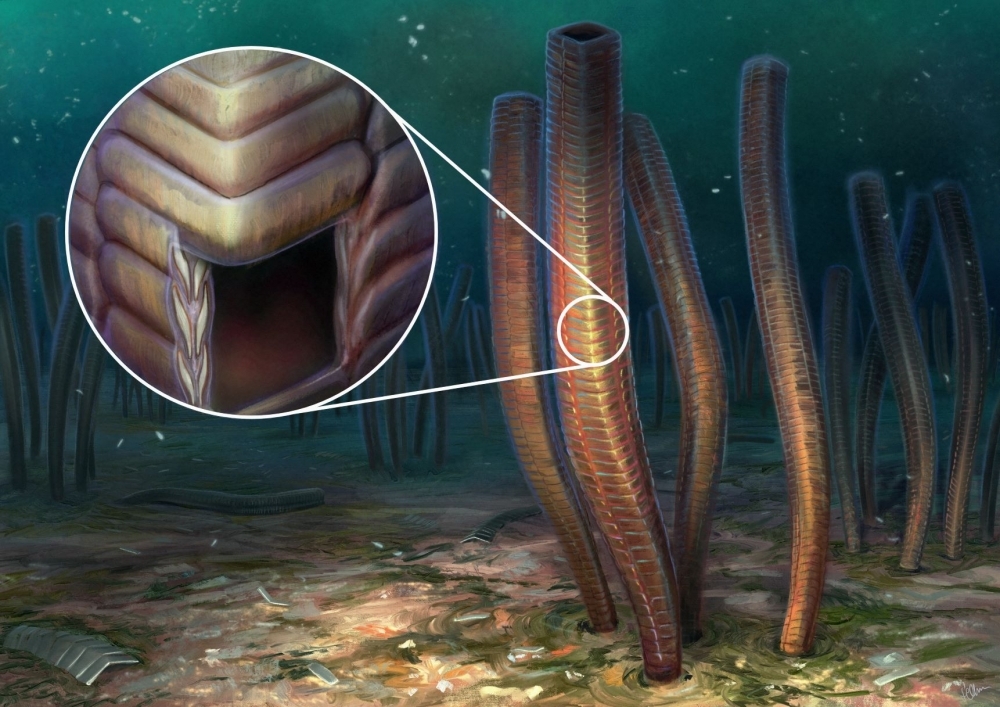


Carapace resembling scaled armor used by medieval knights appears to be first evidence of defense against predators and linked to origin of large group of animals with bilateral symmetry, which includes humans. Advanced techniques including electron microscopy and tomography applied to rocks found in Brazil in the 1970s enabled scientists to reconstruct this animal’s morphology (artistic representation of Corumbella werneri and its environment; detail shows structure of cataphract skel
Published on 06/12/2023
By André Julião | Agência FAPESP – An articulated carapace made up of overlapping but mobile plates, resembling the cataphract armor worn by Roman cavalry and medieval knights, protected Corumbella werneri from predators and may have enabled this prehistoric marine animal to feed on particles suspended in water, a habit never before observed in the Ediacaran period in which it lived, between 635 million and 541 million years ago.
The first specimen of C. werneri, one of the oldest fossilized animals studied to date, was found in 1970 in Corumbá, a city located in Mato Grosso do Sul state (Brazil). Details of its anatomy have now been described in an article published in the journal iScience.
The study was conducted by researchers in Brazil, Scotland and Germany, and was supported by FAPESP. The findings provide a new understanding of the evolution of animals.
“The characteristics of C. werneri make it one of the first modern animals, which probably lived in the presence of predators and food chains similar to those that exist now”, said Gabriel Ladeira Osés, first author of the article. The analysis was part of his PhD research in the Program of Graduate Studies in Ecology and Natural Resources at the Federal University of São Carlos (UFSCar) in São Paulo state, Brazil.
Until quite recently, studies suggested that animals with these characteristics first appeared almost 30 million years later in the event known as the Cambrian explosion. Only disconnected parts of animals with cataphract-type skeletons from the end of the Ediacaran period had been found hitherto.
Based on the findings reported in this latest article, alongside other evidence, it can be concluded that the period saw the emergence of predation, animals visible to the naked eye that moved (possible predators of C. werneri, for example), and skeletons with hard biomineralized component parts.
“We used tomography, electron microscopy, spectroscopy and other geochemical techniques to determine that the skeleton was made of aragonite and self-produced by the animal. It didn’t precipitate later in the fossilization process. We also showed that there was a preferential orientation in the formation of the skeleton, evidencing biological control of mineralization,” said Mírian Liza Alves Forancelli Pacheco, last author of the article and a professor at UFSCar’s Department of Biology.
Evolutionary crossroads
Pacheco was one of the first scientists to study C. werneri, which she researched while studying for her PhD at the University of São Paulo’s Institute of Geosciences (IGc-USP), at a time when no one was sure the fossil was of an animal.
Her research showed that it was indeed an animal, confirming what other Brazilians as well as German scientists had published, and also that C. werneri had a tough skeleton. However, the technology that could determine whether it was organic or mineral did not yet exist. Its mineral nature is demonstrated by this latest study.
These latest results also show that the animal was not entirely tubular, as previously thought, but had a tubular base, while the top had four sides crossed by a line like a polyhedron.
The association between this body shape with the cataphract skeleton may mean it has no biological affinities with the animals that exist now. Nevertheless, C. werneri could be situated halfway between animals with radial and bilateral symmetry, representing one of the most significant and ancient crossroads in their evolution. Almost all animals (including humans) are bilateral, with a body that can be divided into a right side and a left side that are symmetrical to each other.
C. werneri was formerly categorized as belonging to the cnidarians, a group that includes jellyfish, medusae, sea anemones and corals. These animals are all radial, with a type of symmetry in which their body parts are “mirrored” around a central axis (think starfish).
“It was probably attached to the sea floor, with part of its body buried. The articulated armor protected it from predators, probably soft-bodied animals, but was also flexible so that it could sway in the ocean currents. It may have filtered food particles suspended in the water. Future research can help solve what remains of the mystery surrounding this animal,” said Osés, currently a postdoctoral fellow at the Physics Institute (IF-USP).
The study was also supported by FAPESP via a scholarship awarded to Osés to conduct research as a visiting fellow at Edinburgh University in the United Kingdom, and four other projects (22/10829-1, 21/05083-8, 16/06114-6 and 19/03552-0).
The article “Ediacaran Corumbella has a cataphract calcareous skeleton with controlled biomineralization” is at: www.cell.com/iscience/fulltext/S2589-0042(22)01948-4.
Source: https://agencia.fapesp.br/41623